History
After Phillips Park Zoo was established in 1915, a birdhouse was built in 1916. By 1920, the zoo had 5 black bears, 10 monkeys, 19 elk with 19 buffalo, 2 foxes, 1 wolf, and 20 deer, in addition to hundreds of birds. Unfortunately, a hailstorm destroyed the original birdhouse in 1933. After the loss of the birdhouse and Brookfield Zoo opening in 1934, the Phillips Park Zoo refocused on displaying native animals. In 1937, mastodon bones and tusks, which were found in the park, were on display at the zoo causing it to also be known as a museum. Only two major projects took place in the zoo history between 1937 and the 1980s. In 1950, a barn was built. Then in 1964, a water wheel was added to the zoo. Swans and other farmyard animals now have their exhibits around these original structures. From the 1980s to the present time, the zoo has created new exhibit areas and added additional animals. The latest of these additions was the cougar exhibit which opened in 2005. Extensive work has also been done on the exhibits for otters, wolves, elks, and remodeling the reptile house. Animal additions included two bald eagles named Kenai and Denali, and Chopper the Caiman. [2]

The Houston Zoo is a 55-acre (22 ha) zoological park located within Hermann Park in Houston, Texas, United States. The zoo houses over 6,000 animals from more than 900 species. It receives around 2 million visitors each year and is the second most visited zoo in the United States, surpassed only by the San Diego Zoo. It is accredited by the Association of Zoos and Aquariums (AZA).
John Ball Zoo is located on the west side of the city of Grand Rapids, Michigan, United States. The John Ball Zoo is situated on the ravines and bluffs along the west edge of the property.

Connecticut's Beardsley Zoo, located in Bridgeport, Connecticut, is the only Association of Zoos and Aquariums (AZA)-accredited zoo in the state of Connecticut. The zoo includes one of the few carousels in the state. The zoo has around 500 animals, from over 100 species, and welcomes about 280,000 visitors a year.
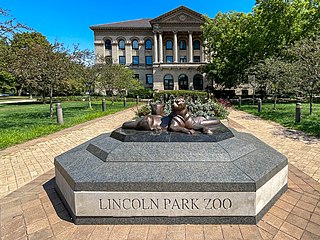
Lincoln Park Zoo, also known as Lincoln Park Zoological Gardens, is a 35-acre (14 ha) zoo in Lincoln Park, Chicago, Illinois. The zoo was founded in 1868, making it the fourth oldest zoo in North America. It is also one of a few free admission zoos in all of North America. The zoo is an accredited member of the Association of Zoos and Aquariums (AZA). The zoo also became an accredited arboretum in 2019.

The Cheyenne Mountain Zoo is a zoological park located southwest of downtown Colorado Springs, Colorado, on Cheyenne Mountain in the United States. At an elevation of 6,714 feet (2,046 m) above sea level, it is the highest zoo in the country. The zoo covers 140 acres (57 ha), 40 of which are in use. The zoo houses more than 750 animals, representing nearly 170 different species, with more than 30 endangered species. The zoo was ranked the #4 best zoo in North America in 2018 by USA Today. It is accredited by the Association of Zoos and Aquariums.
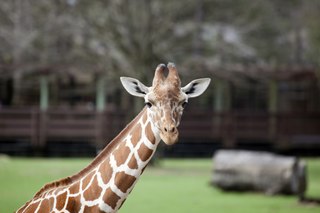
Montgomery Zoo is a 40-acre (16 ha) zoo located on the north side of Montgomery, Alabama. The zoo is an independent city department, and is supported in part by The Montgomery Area Zoolocal Society. It is home to approximately 750 animals representing 140 species. After not renewing their Association of Zoos and Aquariums membership in 2013, the zoo opted to remain accredited solely by the Zoological Association of America. The Mann Wildlife Learning Museum opened in January 2003 and serves as the administration building. The museum features taxidermy displays with a focus on native wildlife, game species, and wildlife management.

The Maryland Zoo — also known as The Maryland Zoo in Baltimore and formerly known as The Baltimore City Zoo or the Baltimore Zoo — is a 135-acre park located in historic Druid Hill Park in the northwestern area of the City of Baltimore, Maryland, with the postal address of 1876 Mansion House Drive. Druid Hill was opened in 1876 as the first major park purchase by the City under foreseeing Mayor Thomas Swann (1809-1883), and was later designed by famed nationally-known landscaper Frederick Law Olmsted (1822-1903).

The Buttonwood Park Zoo, located in New Bedford, Massachusetts, is a zoo located in the center of Buttonwood Park. Opened in 1894, it is the third-oldest zoo in New England and the 12th-oldest zoo in the United States. Located on a 7 acres (2.8 ha) campus, the zoo is owned and operated by the City of New Bedford, with the support of the Buttonwood Park Zoological Society. It is located on part of the Buttonwood Park Historic District, and federally designated on the National Register of Historic Places.
Chahinkapa Zoo is an 29-acre (12 ha) zoo in Wahpeton, North Dakota. Opened in 1933 on land that had been purchased in 1903, it is the first zoo built in North Dakota. It is open May through October and by appointment during the winter. It features over 200 animals ranging from gibbon apes to Bengal tigers and White rhinos.
The Roger Williams Park Zoo of Providence, Rhode Island, contains more than 800 animals in natural settings from a total of 160 species from around the world. In 1986, the zoo became the first zoo in New England to earn accreditation from the Association of Zoos and Aquariums. Founded in 1872, the zoo is the third oldest zoo in the nation. The zoo and the nearby Carousel Village are some of the main attractions of Roger Williams Park.
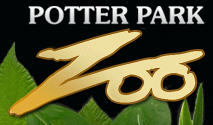
The Potter Park Zoo is a 102-acre (41.3 ha) zoo located in Lansing, Michigan, within Lansing's Potter Park. Its mission is to Inspire people to conserve animals in the natural world. Potter Park Zoo is the oldest public zoo in Michigan and is currently home to over 160 species of animals. The zoo is owned by the City of Lansing, and operated by Ingham County. The zoo participates in the Association of Zoos and Aquariums (AZA) Species Survival Plan (SSP) designed to manage and conserve threatened or endangered animals. The Michigan State University College of Veterinary Medicine partners with the zoo to provide medical care for its animals.
Miller Park Zoo is a zoo located in Miller Park, a public park in Bloomington, Illinois, United States. It is administered by the Parks and Recreation Department of the City of Bloomington.
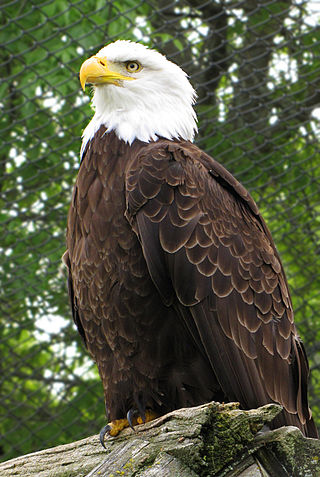
The Magnetic Hill Zoo is a 16-hectare (40-acre) zoo located adjacent to Magnetic Hill and the Magic Mountain in the Magnetic Hill Area of Moncton, New Brunswick. The zoo has over 400 animals, making it the largest zoo in Atlantic Canada. In 2008, the zoo was rated fourth on a list of Canada's top ten zoos.
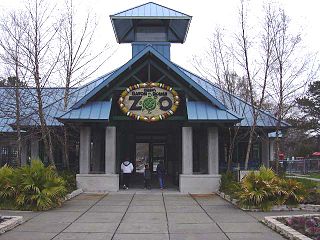
The Baton Rouge Zoo is located 15 minutes north of downtown Baton Rouge, Louisiana, United States. The zoo is owned and operated by the Recreation and Park Commission of East Baton Rouge Parish, Louisiana (BREC), and is home to over 800 animals from around the world. The zoo was first accredited by the Association of Zoos and Aquariums (AZA) in 1977 — the first zoo in Louisiana to be accredited. The zoo lost its accreditation in March 2018 due to infrastructure issues and animal escapes, but regained it in 2024

Orana Wildlife Park is New Zealand's only open-range zoo, sitting on 80 hectares of land, located on the outskirts of Christchurch. It opened in 1976, and is owned and operated by the Orana Wildlife Trust, a registered charity. The aims of the Trust are to provide quality recreational opportunities for local people and visitors to Christchurch; conserve endangered native and exotic wildlife; educate visitors about environmental and conservation issues; and support research relating to endangered animals.

Brandywine Zoo is a small 4.7-acre (1.9 ha) zoo that opened in 1905 in Brandywine Park in Wilmington, Delaware, United States. It is located on the banks of the Brandywine River. The zoo is managed by the Delaware Division of Parks and Recreation and supported by the Delaware Zoological Society. It is usually open daily, 10AM – 4PM, weather permitting.

Metro Richmond Zoo is a privately owned, for-profit zoo in Chesterfield County, Virginia. It is located in the central Virginia area, off of U.S. Route 360, about 20 miles southwest of Richmond. Metro Richmond Zoo encompasses about 70 acres (28 ha) and houses around 2,000 animals representing over 190 species, including reticulated giraffe, white rhinoceros, snow leopard, cheetah and Grant's zebra.

The West Virginia State Wildlife Center is a zoological park in French Creek, West Virginia. Operated by the West Virginia Division of Natural Resources, the Wildlife Center displays many of West Virginia's wildlife, including both native and introduced species. A few of the animals at the Wildlife Center were once found naturally in West Virginia, but were extirpated by the early 1900s.

Northwest Trek Wildlife Park is a 723-acre (293 ha) wildlife park located near the town of Eatonville, Washington, United States. The park is home to black and grizzly bears, grey wolves, bald eagles, a cougar, wolverines, bobcats and more. Its primary feature is a tram tour which takes visitors through a 435-acre (176 ha) free-roam area. The park also allows guests to drive their own vehicles past bison, mountain goats, Roosevelt elk, deer, caribou, swans and more on a Wild Drive tour. Guests can also take a premier Keeper Adventure Tour and go off-road in a Jeep with a keeper and up close to wildlife. The Zip Wild zipline is also open seasonally.

Como Zoo was the first zoo established in Minnesota. Founded in 1897, when the then mayor of Saint Paul wanted a place for his deer to live. The zoo is located within Como Park, in Saint Paul, Minnesota. Como Zoo is a member of the Association of Zoos and Aquariums (AZA).




















